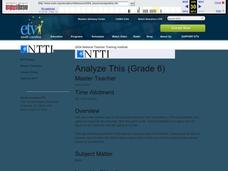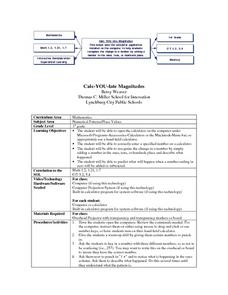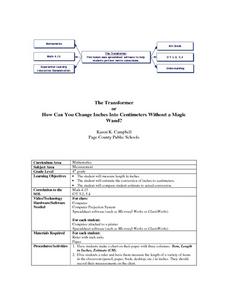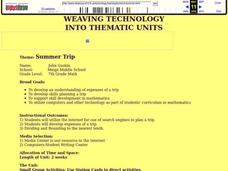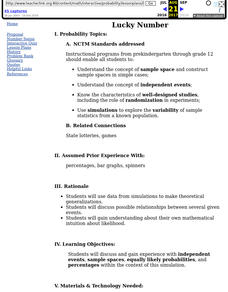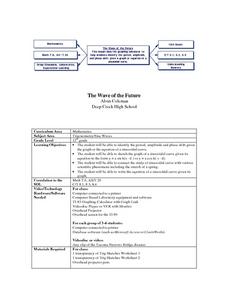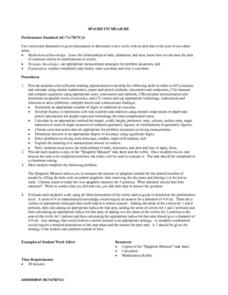Curated OER
Total Daily Calories
Students explore the concept of calories. In this calories lesson, students calculate their Basal Metabolic Rate. Students determine the number of calories they burn each day. Students use a conversion factor of fat to calories to...
Curated OER
Chinese Tangrams
Students research the history of Chinese tangrams and complete tangram activities. In this tangram lesson, students complete Internet research to learn the history of Chinese tangrams. Students construct a set of tangrams, compare the...
Curated OER
Analyze This
Sixth graders use a video and the internet to determine whether a game is fair or unfair. In this probabilities lesson plan, 6th graders determine the fairness of a game based on the probabilities of the outcomes.
Curated OER
Linking Algebra to Temperature
Learners convert between two units as they calculate the temperature. In this algebra lesson, students collect data on seasonal climate and create a graph. They make conjectures based on their data collection.
Curated OER
Daily Time Ratios
Students track and record how much time they spend on each activity. In this spreadsheet instructional activity, students apply different functions using Microsoft excel to format cells and calculate the sum of their total time...
Curated OER
The Lift Equation
Students use the FoilSim educational software program to complete an activity regarding lift. They solve a multivariable equation for each of the variables and apply the results to various problems in different situations.
Curated OER
Altimetry
Fifth graders accurately measure the distance to eight points on an uneven surface by conducting a simulation of sattelite altimetry. They create a two-dimensional model of the simulated ocean surface by graphing data from the Radar Run...
Curated OER
Our Geometric World
Third graders explore the attributes of polygons. In this geometric shapes lesson, 3rd graders review quadrilaterals, squares, rectangles, triangles, pentagons, hexagons, and octagons in order to create hanging polygons. Students then...
Curated OER
Calc-You-Late Magnitudes
First graders are introduced and practice using a calculator. Individually, they enter and complete simple addition and subtraction problems. After the answer is displayed, they identify the place value for ones, tens, and hundreds...
Curated OER
Graphing Galore!
Students practice sorting and counting different objects. Using this information, they create graphs on a worksheet given to them. They describe and analyze the results and discuss them as a class to end the lesson plan. They also...
Curated OER
Bon Voyage: Travel and Exploration
Pupils use the internet and other media to locate and collect information about travel. They interpret the information they collect and convert American currency to foreign currency. Students create scale drawings of travel cards.
Curated OER
The Transformer
Fourth graders practice measuring different objects in inches. Individually, they estimate the length of the same object in centimeters and then calculate the actual length. They compare and contrast their estimate to the actual length...
Curated OER
Summer Trip
Seventh graders utilize the Internet for use of search engines to plan a trip. They research and develop expenses for a trip and divide and round the cost of things to the nearest tenth.
Curated OER
Lucky Number
Students use data from simulations to make theoretical generalizations. They discuss possible relationships between several given events and gain understanding about their own mathematical intuition about likelihood.
Curated OER
The Wave of the Future
Twelfth graders discuss sine curves and enter equations into their graphing calculator then compare different graphs created on their calculators. They identify the period, amplitude and phase shift given the graph or the equation of a...
Curated OER
Escape The Hangman
Seventh graders investigate the concept of probability. They use the game of hangman to create engagement and context for conducting the lesson. They create a spreadsheet with data that is given. Students make predictions based on data.
Curated OER
Measuring "pHacts" about Acid Rain
Sixth graders gather and graph information regarding the pH of rain. Working cooperatively with an internet partner, 6th graders gather and record information about the pH of the rain in their local area. They graph this information...
Curated OER
Spaghetti Measure
Students receive a copy of a "Spaghetti Measure" task sheet along with the scoring rubric. Students preview the task and the rubric prior to starting the task. tudeThey determine the circumference of a circle of spaghetti that will...
Curated OER
Save Your Change
Students solve problems involving exponential, logarithmic, and scientific notations. Using calculators, students explore investment problems. They use a formula and logarithms to determine the years to earn a particular income, figure...
Curated OER
Totally Tessellations!
Eighth graders investigate the concept of tessellations and transformations. They create patterns to demonstrate and practice the skill. Students write a description of the pattern for others to interpret. The pattern is assessed...
Curated OER
Kinder Bakeshop
Pupils create a bakery where they sell cookies for a week. Students identify and interpret how to make their own money and deposit it into their bank accounts. Pupils also identify how to withdraw money from these accounts in order to...
Curated OER
Indegenous Cultures Magazine in Publisher
Fourth graders use Publisher to create their own magazine. In this online magazine lesson, 4th graders follow the instructions to create a magazine using text, pictures, and colors within the Publisher system.
Curated OER
Highway Design for the Future
Eighth graders research highway designs and create a marble maze to illustrate a highway system. They test their designs and write reports defining the project and analyzing the results.
Curated OER
Welcome To Program A Simple Program in C
Students are introduced to the language in C programming. In groups, they determine the correct function to be used and practice running the program to achieve the desired results. They end the lesson by programming more difficult...


